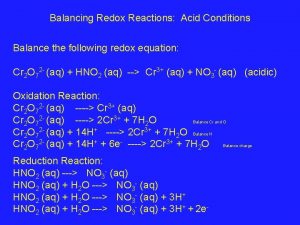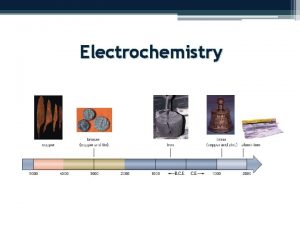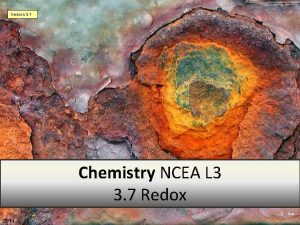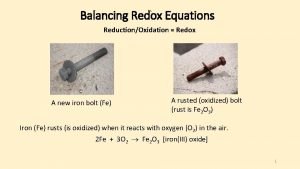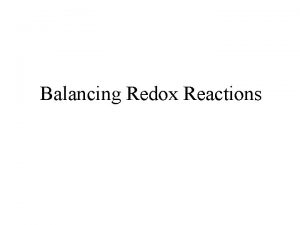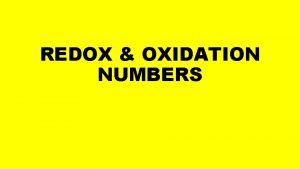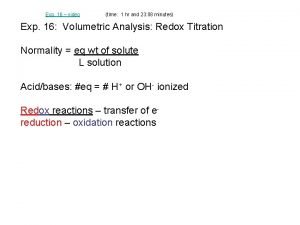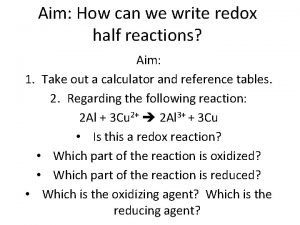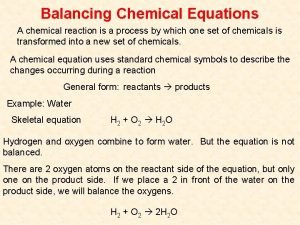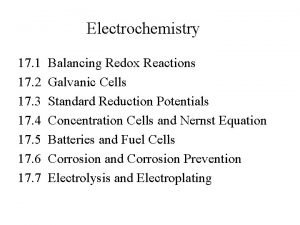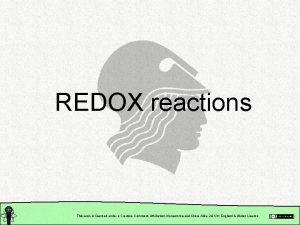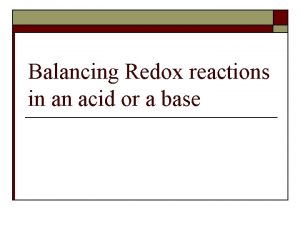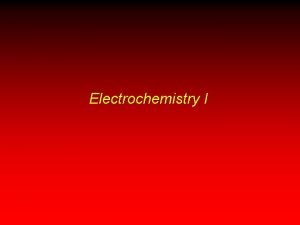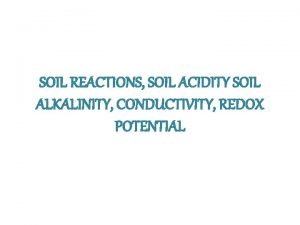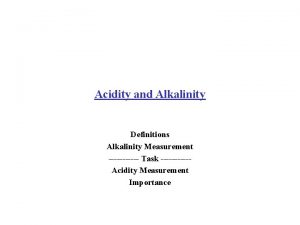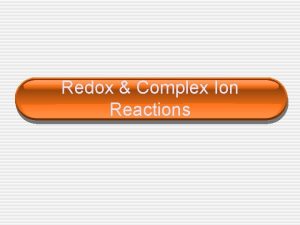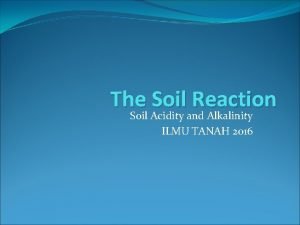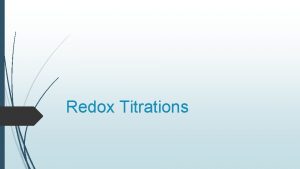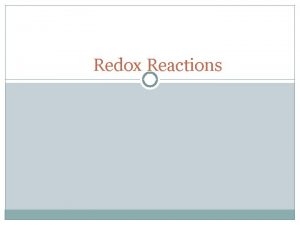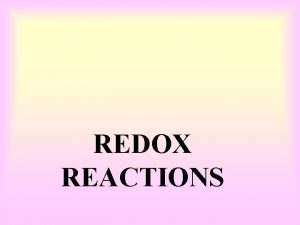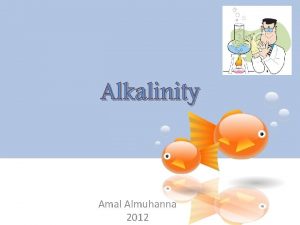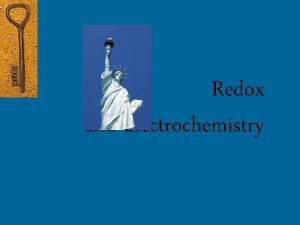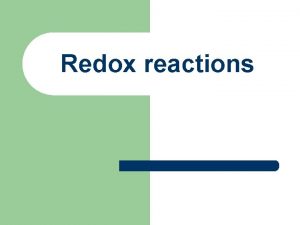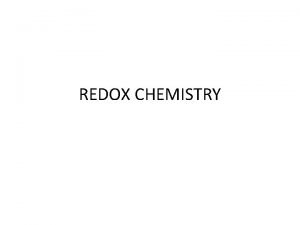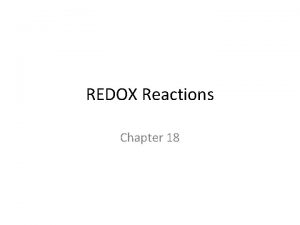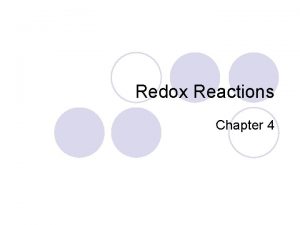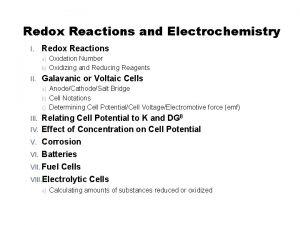SOIL REACTIONS SOIL ACIDITY SOIL ALKALINITY CONDUCTIVITY REDOX






















- Slides: 22

SOIL REACTIONS, SOIL ACIDITY SOIL ALKALINITY, CONDUCTIVITY, REDOX POTENTIAL

SOIL REACTIONS • Soil reaction (p. H) - an indication of the acidity or ability of the soil • Measured in p. H units • p. H 7. 0 to 0. 0 – acidic soil; 7. 0 to 14. 0 alkaline soil • Strongly acidic soils (p. H 4. 0 -5. 0) - have high and toxic concentrations of soluble ions of aluminum (Al+++) and manganese (Mn++) • Most minerals are more soluble in acid soils than the neutral or slightly alkaline soils • Mineral soils (p. H 6. 5) - suitable for agricultural crop • The organic soils (p. H 5. 5) - unsuitable for agriculture

• Soil become acidic even from basic parent materials by the leaching of the basic cat ion (Ca++, Mg++, K+ Na+) • Replacement of H+ ions from carbonic acid (H 2 CO 3 --) formed from water and dissolved carbon dioxide • Soils of higher p. H than 9. 0 have reduced growth of plants or even death • Increase of excess exchangeable sodium in the soil is removed by adding gypsum followed by irrigation to leach the exchangeable sodium ions • Leaching of basic cations is more in humid regions than arid regions in there soils

• Leaching is less in arid region, Ca. CO 3 and often bases accumulate near the surface and become neutral or slightly alkaline (p. H near 8. 0) • In extremely arid climates less rainfall to flush solvable salt, such soils are called saline soils • Acids - water solutions that certain more H+ cat ions than OH- anions • Bases - water solution containing more OH- anions than H+ cat ions • The concentration of OH- ions in solution determines the alkalinity • The acidity or alkalinity of a soil depends largely on the balance between the negatively charged anions (Cl-, SO 4 -, NO 3 -) and the positively charged basic cat ions (Ca++ , Mg++, K+, Na+)

• The p. H rises when the concentrations of bases increase and drops when the concentrations acidic cat ions increase • Aluminum toxicity can be avoided in the soil by maintaining soil p. H above 5. 0 • The dominant bases in cat ion exchange are calcium and magnesium • Calcium - 75 to 85% of exchangeable basis • Soil of p. H above 8. 0 has high percentage of sodium ions • Soils of p. H below 4. 0 contain sulfuric acid

SOIL FERTILITY • soil fertility and soil productivity - basic need • The nutrients essential for plant growth is called soil fertility • Factor limiting production- poor drainage, insects, drought etc • Organic matter and soil organisms immobilize the release of nutrients

Soil Productivity • Productivity - capacity of soil to produce crops and be expressed in terms of yield • Plant needs soil for mechanical support, nutrients, water, air and heat

Essential Nutrients • • • Carbon (CO 3 --, HCO 3 -) Hydrogen (H+) Oxygen (O-) Nitrogen (NH 4+, N- N 03 -) Phosphorus (HP 04 --, H 2 P 04 -) Potassium (K+) Calcium (Ca++) Magnesium (Mg++) Sulfur (SO 3 -SO 4) Iron (Fe+++) • • • Manganese (Mn++); Boron (B 03 --) Molybdenum (MOO 4) Zinc++), Copper (Cu+ Cu++) Chlorine (Cl-) In addition sodium (Na+) Cobalt (CO+) Vanadium & Silicon (Sio 3) are essential

• Basic nutrients – carbon and oxygen - 96% of total dry matter of the plant • Carbon and oxygen - 45% each and hydrogen - 6% of the total tissue • These elements are abundant and supplied from the atmosphere - need not be applied and do not limit the production

Macro nutrients • Nutrients required in small quantity; also called trace elements • They are Fe, Zn, Cs, Mn, B, Mo and Cl • Slight deficiency or excess is harmful to the plant growth Factors influence nutrients availability • Parent material and type of vegetation • Soil p. H • Commercial fertilizers, manure and compost • Activity of microorganisms • Soil temperature, moisture and aeration

ORGANIC CARBON • Organic matter - growth promoting substance; reservoir of nutrients • Contains considerable potential energy of which large proportion of which is readily transferable and used by plants • Carbon - common constituent of all organic matter

• Much of the energy acquired by the fauna and flora with in the soil comes from the oxidation of carbon • Organic matter - influences physical and chemical properties of soil • Also supplies energy and body building constituents for microorganisms • The sources of soil organic matter - plant tissue and animals

Compositions of higher plants • Water - 75% • Hydrogen - 2% • Oxygen - 10 • Carbon - 11% • Ash • Plant tissue - made of largely of carbon, hydrogen and oxygen • The nitrogen included in ash; Also, contains sulphur , iron, phosphorus etc - 2%

Oxidation of Organic Carbon: (1 C, 4 H) + 2 O 2 Enzymic Oxidation CO 2 + 2 H 2 O + Energy Breakdown of proteins • Protein forms- Carbon dioxide, ammonium compounds, nitrate -nitrogen etc. Microbial Decomposition: • Carbonn – CO 2, CO 3 -- , HCO 3 - , CH 4 • Nitrogen – NH 4+, NO 2 -, NO 3 • Sulphur S, H 2 S, SO 3 --, SO 4 --, CS 2 • Phosphorus - H 2 SO 4 - , HPO 4— • Others - H 2 O, O 2, H 2 , H+, OH- , K+, Ca++ , Mg++ etc

HUMUS • Humus - mixture of complex compounds • The compounds are either resistant or compound synthesized with in microbial tissues • Humus - complex and rather resistant mixture of brown or dark brown amorphous and colloidal substances modified from the original tissues or synthesized by the various organisms

• Highly colloidal, mostly amorphous and not crystalline • Has more surface area, absorptive capacity, low plasticity and cohesion • Humic micelles carry a swarm of adsorbed cat ions -O- Ca++ Humus -Coo-OCOO Al++ Mg++ H+ Na+ K+ NH 4+

Importance of soil organic matter • Physical properties – granulation, plasticity, cohesion reduced • Water holding capacity - increased • High cat ion absorption capacity of nutrients – 2 to 30 times and adsorbing capacity for 30 -90% • Supply and availability of nutrients – replaceable cat ions, N, P and S and extraction of elements from humus

CARBON: NITROGEN RATIO • Carbon makes up a large and rather definite proportion of organic matter • Not surprising that the carbon nitrogen ratio of soils is fairly constant • carbon to nitrogen ratio in the organic matter of arable soil - ranges from 8: 1 to 15: 1; medium being between 10 and 12 to 1 • C: N ratio tends to be low in soils of arid regions than humid regions

• C: N ratio is narrower for sub-soils than surface soils • The ratio of C: N of plant material ranged from 20 to 30 to 1 for legumes and farm manure to as high as 90 to 1 • The available nitrogen results where residuals have high C: N ratio • Due to constancy of C. N ration Nitrogen do not become Nutrient

CONDUCTVITY OF SOIL • The cat ions and anions in soil carry current and important in conductivity of charges • Higher concentration of ions in solution - more electric conductance • Thus, the measurement of EC can be directly related to the soluble salts concentration • Electrical conductivity provides a rapid and reasonable accurate estimate of solute courses • Conductance is the reciprocal of the resistance and the unit of measure is the reciprocal of ohm designated as mho or Siemens (s)

REDOX POTENTIAL: • The value of redox potential indicates the state of oxidation and reduction process in soil or water • A lower value of redox potential indicates high reduction while a high value of it indicates high oxidation • For better aerobic treatment, waste water should be high (+200 to +600 mv) • For anaerobic treatment it should be below -100 to – 200 mv

 Example of oxidation reduction reaction
Example of oxidation reduction reaction Shear strength of soil ppt
Shear strength of soil ppt Balancing redox reactions
Balancing redox reactions Building redox tables
Building redox tables Redox reaction
Redox reaction Redox reactions ncea level 2
Redox reactions ncea level 2 Leo goes ger
Leo goes ger Galvanic cell khan academy
Galvanic cell khan academy Different types of redox reactions
Different types of redox reactions Rules for balancing redox reactions
Rules for balancing redox reactions Concentration cell definition
Concentration cell definition Oxidation states chemsheets answers
Oxidation states chemsheets answers Complex redox reactions
Complex redox reactions Redox oilrig
Redox oilrig Balancing redox reactions
Balancing redox reactions How to write redox half reactions
How to write redox half reactions Rules for balancing redox reactions
Rules for balancing redox reactions Downs cell
Downs cell How redox reactions work
How redox reactions work Balancing redox reactions in acid
Balancing redox reactions in acid Reactions that produce gas
Reactions that produce gas Voltaic cell components
Voltaic cell components Cell reaction in electrochemistry
Cell reaction in electrochemistry


